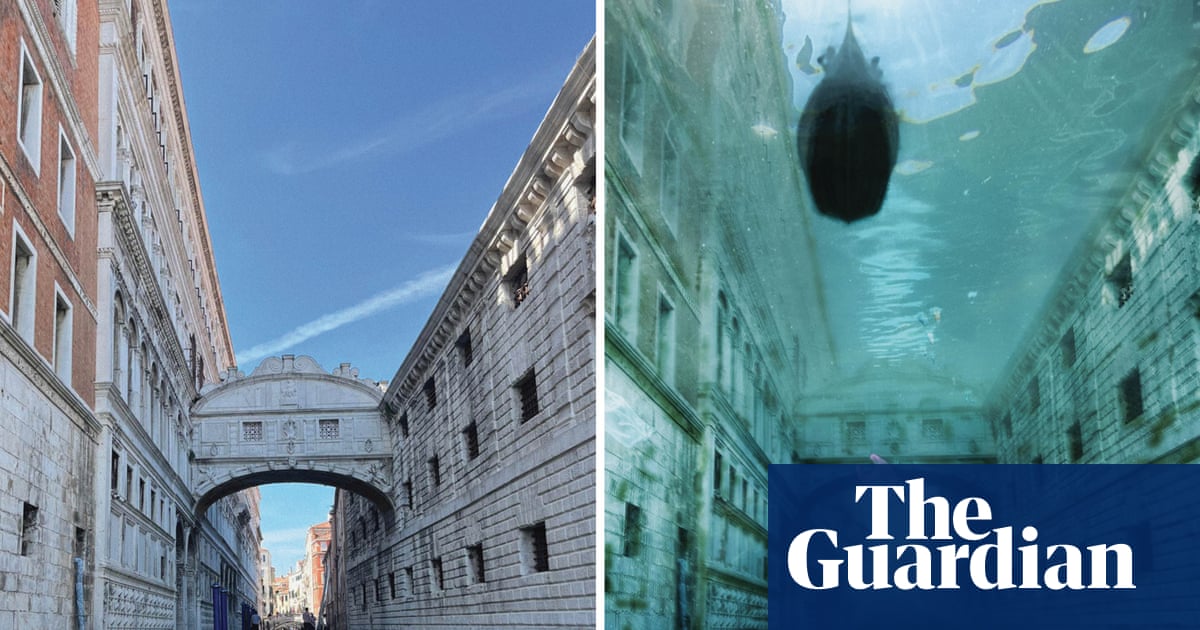Artists have created visualisations of the impact of the climate crisis on some of the world’s most recognisable landscapes, in a project to highlight the environmental effects of tech consumption.
Venice in Italy, the Giant’s Causeway in Northern Ireland, Iguazu Falls on the border of Argentina and Brazil, and the Seine River in Paris were among the locations used to explore to potential impacts of the climate crisis by the end of the century. The results are on display at an exhibition in London.
Giant’s Causeway, now and visualisedGiant’s Causeway, now and visualised. By Alex Griffiths
Mark Maslin, a professor of earth system science at University College London, used climate modelling to examine the low-end and top-end damage at each location. His findings were interpreted by a group of artists for the show at the Last Shot Gallery by Back Market. The artistic works are not intended to be taken as literal predictions of what will happen in these locations, but to raise awareness of the threat posed by climate breakdown.
Maslin said the environmental impact of tech consumption was estimated to account for 6% of the human-driven climate crisis; double that of the aviation industry.
“There is a lack of awareness that all the gadgets people are using and replacing are contributing to overconsumption, huge pollution and climate change,” he said. “We are trying to raise that awareness. I don’t think people using their phone every single day have any idea of its impact on the planet.”
Moraine Lake in Canada, now and visualisedMoraine Lake in Canada, now and visualised. By Hugh Jardine
The climate damage caused by fast tech stems from the mining of materials such as tantalum, cobalt and tin – a process with serious social and environmental repercussions – and the disposal of e-waste, which releases harmful greenhouse gases, such as methane and carbon dioxide, when incinerated or pollutes soil and water with toxic chemicals from improper landfill disposal.
He said legislation to curb built-in obsolescence was being introduced by the EU, including rules for universal chargers rather than the plethora of wires and plugs that piled up in people’s homes.
Tech companies are pushing back, accusing the bloc and other legislators of interfering in the free market. The EU adopted a directive in June 2024 that mandates repairs for a wider range of products, extends legal guarantees and prohibits manufacturers from blocking third-party parts.
Iguazu Falls, now and visualisedIguazu Falls, now and visualised by Osman G
The UK has had regulations since 2021 that apply to certain appliances, but there are concerns over their effectiveness.
Luke Forshaw, the head of brand and marketing at Back Market, a global marketplace dedicated to refurbished technology that produced the exhibition with Maslin, said: “Our research shows that while people recognise the changes happening around them, too many still don’t see how their everyday choices, particularly around tech, connect to the bigger picture.”
Venice – now and visualisedVenice – now and visualised. By Archie McGrath and Josiah Naguar
In 2022, a record 62m tonnes of electronic waste was produced, making it one of the world’s fastest-growing waste streams. According to Forshaw, there has never been a more critical moment to rethink our relationship with technology and choose longevity over landfill. “Making sustainable options more affordable, accessible and transparent is key to bridging that gap,” he said.
Five ways you can reduce carbon emissionsYour mobile phone contains reusable precious materials. Photograph: Maksym Yemelyanov/Alamy
Find a piece of tech you are comfortable with and keep it.
Remember that your mobile phone contains precious materials that should be reused rather than thrown away.
Sell your old phones and devices to reputable reuse shops or via peer-to-peer sales.
Keep your phone battery at between 20-80% for optimal life.
Keep your device clean and remove dust from charging ports.
The exhibition is at the Last Shot Gallery in Fitzrovia, central London, on 17 October.

